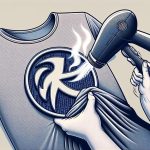Are you the proud owner of a garment that’s been embroidered with a design that no longer suits your taste? Maybe you’ve inherited a piece of clothing that has someone else’s initials stitched onto it, or you’ve purchased a jacket that has an embroidered logo that clashes with your personal style.
Whatever the reason, you may be wondering if it’s possible to have the embroidery removed. The answer is yes, a skilled tailor can remove embroidery from most types of fabric, but it’s important to consider a few factors before deciding whether to go ahead with the process.
Firstly, the type of embroidery and fabric will play a significant role in determining whether or not the embroidery can be safely removed without damaging the garment. Secondly, you’ll need to find a tailor who has experience in embroidery removal and is skilled enough to do the job properly.
In this article, we’ll explore the types of embroidery and fabric that can be safely removed, the factors to consider before proceeding with embroidery removal, and the steps involved in the embroidery removal process.
Table of Contents
Types of Embroidery
You’ll want to be careful when asking a tailor to remove embroidery, as the type of embroidery used can greatly affect the difficulty and outcome of the removal process.
There are many types of embroidery, including hand embroidery, machine embroidery, and applique embroidery. Hand embroidery is done by hand and can be very intricate, while machine embroidery is done by a machine and can be quicker and more uniform. Applique embroidery involves adding a separate piece of fabric to the design.
When it comes to removing embroidery, hand embroidery can be the most difficult to remove. This is because the stitches are often tightly woven and can be difficult to unravel without damaging the fabric underneath.
Machine embroidery can also be difficult to remove, depending on the type of thread used and how it was stitched onto the fabric. Applique embroidery, on the other hand, can be easier to remove as the separate piece of fabric can be carefully cut away from the design.
It’s important to keep in mind that the type of fabric the embroidery is on can also affect the removal process. Delicate fabrics like silk or lace may require more careful removal techniques to avoid damaging the fabric.
When considering having embroidery removed, it’s always best to consult with a tailor who has experience with embroidery removal to ensure the best outcome.
Types of Fabric
Cotton, silk, and wool are just a few examples of the various types of fabric used in clothing. But did you know that each type of fabric requires different care and attention? Here are some types of fabric you may encounter:
-
Linen is a lightweight and breathable fabric, perfect for summer clothing. However, it wrinkles easily and should be ironed on a low heat setting.
-
Polyester is a durable and easy-to-care-for fabric, often used in athletic wear. It can be washed in the machine, but avoid high temperatures when drying.
-
Denim is a sturdy and versatile fabric, commonly used in jeans. It can be washed in the machine, but be careful not to mix with light-colored clothing as it may bleed dye.
-
Cashmere is a soft and luxurious fabric, often used in sweaters and scarves. It should be hand-washed or dry cleaned to maintain its quality.
When it comes to embroidery removal, the type of fabric is an important factor to consider. Some fabrics may be more delicate and prone to damage when embroidery is removed. For example, silk and cashmere require special care and should only be handled by a professional tailor. On the other hand, cotton and polyester are more durable and may be easier to remove embroidery from at home.
In any case, it’s always best to consult a professional tailor before attempting to remove embroidery yourself. They can advise you on the best course of action based on the type of fabric and the embroidery placement. With the right care, your clothing can look as good as new without any unwanted embellishments.
Factors to Consider
When deciding whether a tailor can remove embroidery from a garment, there are three factors to consider.
Firstly, you should consider the purpose of the garment. Is it for a special occasion or everyday wear?
Secondly, you should assess the value of the embroidery. Is it a valuable heirloom or simply decorative?
Lastly, you should take into account the potential damage that could be caused to the fabric during the removal process.
By considering these factors, you can make an informed decision about whether or not to remove embroidery from a garment.
Purpose of the Garment
The purpose of a garment can greatly impact whether or not a tailor is able to successfully remove embroidery. If the garment is sentimental, such as a wedding dress or heirloom item, the embroidery may hold significant emotional value. In this case, the decision to remove the embroidery should not be taken lightly and should be carefully considered.
Here are some things to keep in mind when deciding whether or not to remove embroidery from a sentimental garment:
-
Is the embroidery an important part of the garment’s history?
-
Will removing the embroidery negatively impact the overall aesthetic of the garment?
-
Can the embroidery be saved or repurposed in some way?
-
Will removing the embroidery significantly decrease the value of the garment?
By considering these factors, you can make an informed decision about whether or not to remove embroidery from a sentimental garment. Ultimately, the decision should be based on what will preserve the integrity and value of the garment for years to come.
Value of the Embroidery
Don’t miss out on unlocking the potential of your embroidered garments by underestimating their value! Embroidery adds a unique touch to any outfit, making it stand out and adding a level of sophistication.
The intricacy and detail of embroidery can add significant value to a garment, making it a prized possession in your wardrobe. Embroidery can also hold sentimental value, especially if it was custom-made or given as a gift.
It can be a representation of a special moment or memory, and removing it may detract from its overall worth. So, before making the decision to remove embroidery from a garment, consider its value and importance to you.
It may be worth keeping it as is and finding ways to incorporate it into your wardrobe.
Damage to the Fabric
Unfortunately, excessive embroidery can cause damage to the fabric over time, leading to tears or holes. While the embroidery may look beautiful and add value to the garment, it could also compromise the integrity of the fabric.
Here are some reasons why:
- The embroidery thread can cause friction against the fabric, leading to wear and tear.
- If the embroidery is done on a thin or delicate fabric, the weight of the embroidery can stretch or distort the fabric over time.
- Embroidery may also cause the fabric to weaken, as the needle may create small holes in the fabric that could eventually lead to tears.
If you have noticed any signs of damage to the fabric due to excessive embroidery, it may be time to consider having it removed. A skilled tailor can work to carefully remove the embroidery without causing further damage to the fabric. However, it’s important to note that the removal process may not be 100% successful in restoring the fabric to its original state. It’s always best to consult with a professional tailor to determine the best course of action for your specific garment.
Finding a Skilled Tailor
You’ll be thrilled to know that finding a skilled tailor to remove embroidery is a breeze if you follow these simple steps. First, start by doing your research. Look up tailors in your area and read reviews from past customers. This will give you an idea of the tailor’s quality of work and whether they have experience with embroidery removal.
Once you’ve narrowed down your options, it’s time to make some phone calls. Call each tailor and ask if they have experience with removing embroidery. Be sure to ask about their pricing and turnaround time as well. This will help you compare and choose the best option for your needs.
Schedule an appointment with the tailor you’ve chosen. Bring in the item that needs embroidery removal and discuss your expectations with the tailor. They should be able to provide you with a clear plan for removing the embroidery while preserving the fabric. With these simple steps, you’ll be able to find a skilled tailor to remove your embroidery without any hassle or stress.
| Step | Action | ||
|---|---|---|---|
| 1 | Research tailors in your area and read reviews from past customers. | ||
| 2 | Call each tailor and ask if they have experience with removing embroidery, pricing and turnaround time. | ||
| 3 | Schedule an appointment with your chosen tailor and bring in the item that needs embroidery removal. Discuss your expectations with the tailor. | 4 | Once the tailor has completed the embroidery removal, inspect the item to ensure it meets your expectations and pay the agreed upon price. |
The Embroidery Removal Process
When considering removing embroidery from a piece of clothing, the first step is to assess the embroidery and the fabric it’s attached to. This will help determine the best approach for removal.
Once you’ve assessed the embroidery and fabric, it’s important to select the right tools for the job. With the right tools in hand, you can begin the process of removing the embroidery from your garment.
Assessing the Embroidery and Fabric
First, take a close look at the embroidery and fabric to determine if it’s possible for a tailor to remove the embroidery without damaging the fabric. Here are some things to consider:
-
The type of fabric: Some fabrics are more delicate than others and may not be able to withstand the removal process. For example, silk and chiffon are more fragile fabrics that require special care.
-
The type of embroidery: Different types of embroidery require different techniques to remove. For instance, machine embroidery may be easier to remove than hand embroidery.
-
The location of the embroidery: If the embroidery is in a highly visible area, any damage to the fabric may be more noticeable. In contrast, if the embroidery is in a less noticeable area, some minor damage may be acceptable.
Once you have assessed the embroidery and fabric, you can determine if it’s possible for a tailor to remove the embroidery without causing damage.
If the embroidery can be safely removed, the tailor can begin the process of carefully removing each stitch to restore the garment to its original state.
Selecting the Right Tools
Now that you’ve assessed the embroidery and fabric, it’s time to select the right tools for removing the embroidery. This is an important step because using the wrong tools can damage the fabric and make the embroidery removal process even more difficult.
To help you choose the right tools, here is a table that outlines some common embroidery removal tools and their uses:
| Tool | Use |
|---|---|
| Seam ripper | Great for removing small areas of embroidery or stitches. |
| Embroidery scissors | Ideal for cutting threads and trimming excess fabric. |
| Tweezers | Useful for removing small bits of thread or debris left behind after embroidery removal. |
| Cutting mat | Provides a safe and stable surface for cutting and removing embroidery. |
| Fabric marker | Helps mark the areas that need to be removed or trimmed. |
By using the right tools, you can ensure that the embroidery removal process goes smoothly and without any damage to the fabric. Remember to take your time and work carefully, using the tools to gently remove the embroidery one stitch at a time. With patience and the right tools, you can successfully remove embroidery and give your garment a new look.
Removing the Embroidery
Ready to give your garment a fresh new look? Let’s dive into the process of taking off that embroidered design. Removing embroidery can be a delicate process, but with the right tools and techniques, you can have a clean slate to work with.
-
Be patient. Removing embroidery can be time-consuming, especially if it’s a large or intricate design. Take your time and work slowly to avoid damaging the fabric.
-
Use sharp scissors or a seam ripper to carefully cut or pick out the stitches. Be gentle and avoid cutting into the fabric.
-
Clean up any leftover residue or threads using a lint roller or adhesive tape. This will ensure a smooth surface for any future embellishments or alterations.
By following these steps, you can successfully remove embroidery from your garment and start fresh with a new design or look. Don’t be afraid to take a risk and make changes to your clothing – it’s a fun and creative way to express yourself through fashion.
After the Removal
Once the embroidery’s been removed by the tailor, you’ll have a clean canvas to work with and the fabric will feel smoother to the touch. However, you need to be mindful of any leftover holes or marks that may have been left behind by the embroidery.
These holes can be filled with fabric patches or covered up with a new design. If you plan on re-embroidering the fabric, make sure to choose a design that complements the remaining fabric. You don’t want the new embroidery to look out of place or draw attention to the previous design. Also, consider the location of the embroidery.
If the previous embroidery was on a pocket or collar, you may want to avoid re-embroidering in the same spot to prevent overcrowding. Lastly, don’t forget to properly care for the fabric after the embroidery removal. Follow the fabric care instructions and avoid washing it too frequently or with harsh detergents.
You want to ensure that the fabric remains in good condition and doesn’t become damaged from excessive washing or drying. With proper care, your newly cleaned and embroidered fabric will be ready to use or wear in no time!
- How Does Ring Spun Cotton Affect Garment Fit and Shape Retention? - August 13, 2024
- What Are the Challenges in Producing Ring Spun Cotton? - August 13, 2024
- Is Ring Spun Cotton Suitable for Plus-Size Clothing? - August 13, 2024




